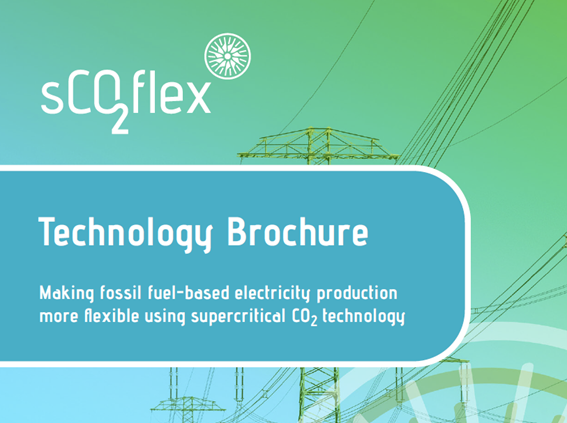The sCO2flex Technology Brochure brings together the key technical outputs of the project, outlining the key aspects of the Plan design, Plant Operation and touching upon the projects potential impact in the context of the EU’s energy transition.
The EU has set itself a long-term goal of reducing greenhouse gas emissions by 80-95%, when compared to 1990 levels, by 2050. The EU 2050 Energy Strategy includes therefore new challenges and opportunities. Renewable energy (such as wind and solar) is gaining momentum and now raises the question of grid stability in the event of large power output fluctuations. In this context, enhancing the flexibility and the performance of conventional power plants is seen as a good opportunity to both secure the energy grid while reducing their environmental impact. Therefore, it is necessary to develop innovative and cost-effective ways of enabling existing and future fossil fuelled power plants to be flexible enough to deal with load fluctuations and to reduce emissions.
Supercritical carbon dioxide (aka sCO2) is a fluid state of carbon dioxide where it is held at or above its critical temperature and critical pressure. The fluid presents interesting properties that promise substantial improvements in conventional power plant system efficiency. Due to its high fluid density, sCO2 enables extremely compact and highly efficient turbomachinery.
The sCO2-flex consortium therefore sought to develop a scalable and modular design of a 25 MWe plant using supercritical CO2 to enable an increase in the operational flexibility (fast load changes, fast start-ups and shutdowns) and efficiency of existing and future solid-fossil power plants, thus reducing their environmental impacts, in line with EU targets. To reach these goals, the project secured a €5 million grant from the European Commission’s Horizon2020 Programme.
The results currently available indicate that a cycle net efficiency of 42.5% can be reached, with a boiler efficiency of 92.3% (based on the fuel’s lower heating value). The resulting plant net efficiency of 37% (including boiler and flue gas treatment auxiliaries) allows a reduction by 8% of the greenhouse gases emissions in operation compared to a water/steam plant of the same power output, and can be operated flexibly between 20% and 100% of its nominal load. Those improvements in performance come at a slightly lower investment cost than a similar water/steam plant, making sCO2 cycles a competitive option at a 25 MWe scale.
